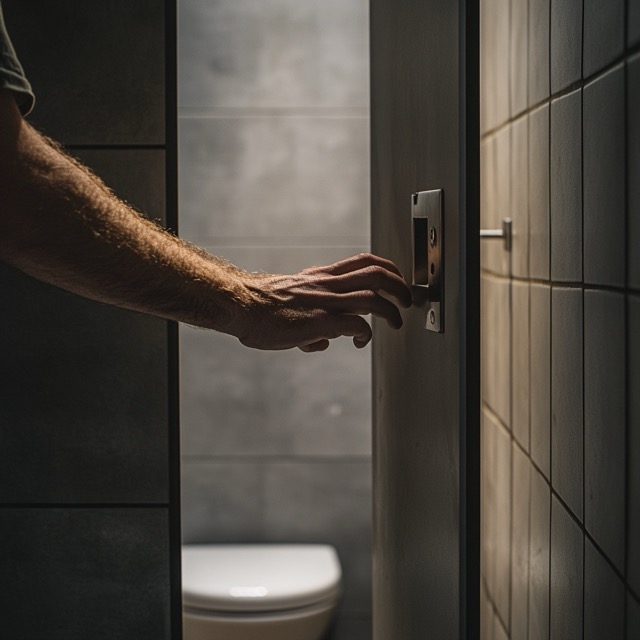Urinary incontinence is a common condition that affects many people, especially veterans. It refers to the loss of bladder control, which can range from occasionally leaking urine when you cough or sneeze to having such a sudden urge to urinate that you can’t make it to the bathroom in time.
For veterans, this condition can be particularly challenging, as it may be related to their military service or other service-connected disabilities. Urinary incontinence can significantly impact quality of life, causing embarrassment, social isolation, and difficulties in daily activities.
It’s important to understand that urinary incontinence is not a disease itself, but rather a symptom of an underlying condition. This distinction is crucial when seeking VA disability benefits, as the underlying cause will play a role in determining eligibility and rating.
Types of Urinary Incontinence
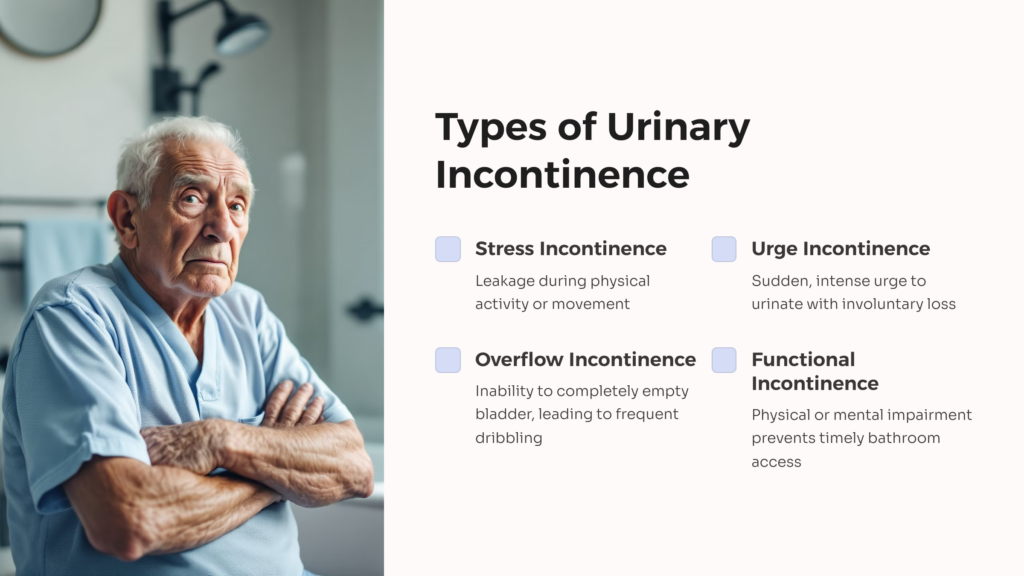
There are several types of urinary incontinence that veterans may experience. Understanding these different types can help in accurately describing symptoms when filing a VA claim.
1. Stress incontinence: This occurs when physical movement or activity puts pressure on your bladder. Actions like coughing, sneezing, laughing, or lifting heavy objects can cause urine leakage.
2. Urge incontinence: Also known as overactive bladder, this type involves a sudden, intense urge to urinate followed by involuntary loss of urine. You may need to urinate frequently, including throughout the night.
3. Overflow incontinence: This happens when you can’t completely empty your bladder, leading to frequent or constant dribbling of urine.
4. Functional incontinence: This type occurs when a physical or mental impairment keeps you from making it to the toilet in time. For example, severe arthritis might make it difficult to unbutton your pants quickly.
5. Mixed incontinence: Some veterans may experience a combination of the above types, most commonly stress and urge incontinence together.
Understanding which type of incontinence you’re dealing with can help your healthcare provider determine the best treatment approach and can also be valuable information when filing a VA disability claim.
Causes of Urinary Incontinence in Veterans
Urinary incontinence in veterans can stem from various causes, many of which may be related to their military service. Understanding these causes is crucial for both treatment and establishing a service connection for VA disability benefits.
Combat injuries or accidents during service can lead to neurological damage or physical trauma that affects bladder control. For instance, spinal cord injuries or traumatic brain injuries (TBI) can disrupt the normal nerve signals that control urination.
Exposure to certain chemicals or toxins during military service, such as Agent Orange, may also contribute to urinary incontinence. Some veterans develop incontinence as a side effect of medications prescribed for service-connected conditions.
Post-Traumatic Stress Disorder (PTSD) has been linked to urinary incontinence in some veterans. The stress and anxiety associated with PTSD can affect bladder function and control. In fact, studies have shown that PTSD is independently associated with urinary incontinence.
Other factors that may contribute to urinary incontinence in veterans include prostate issues in men, childbirth-related pelvic floor weakening in women, and age-related changes to the urinary tract. It’s important to note that these causes may interact with service-connected conditions, potentially qualifying the incontinence as a secondary service-connected disability.
Understanding VA Disability Ratings
VA disability ratings are a way for the Department of Veterans Affairs to measure the severity of a service-connected condition and determine the level of compensation a veteran should receive. These ratings are expressed as percentages, ranging from 0% to 100%, with higher percentages indicating more severe disabilities.
For urinary incontinence, the VA uses a rating system based on voiding dysfunction. This system takes into account factors such as the frequency of urination, the need for absorbent materials, and the impact on daily life activities.
It’s important to understand that a 0% rating doesn’t mean your condition isn’t recognized. It simply means that while the condition is service-connected, it doesn’t meet the criteria for a compensable rating at that time. However, having a 0% rating can be beneficial if the condition worsens in the future, as it establishes service connection.
The VA uses the Combined Ratings Table to calculate the overall disability rating when a veteran has multiple service-connected conditions. This means that if you have urinary incontinence in addition to other service-connected disabilities, your combined rating could be higher than your individual ratings might suggest.
Rating Criteria for Urinary Incontinence
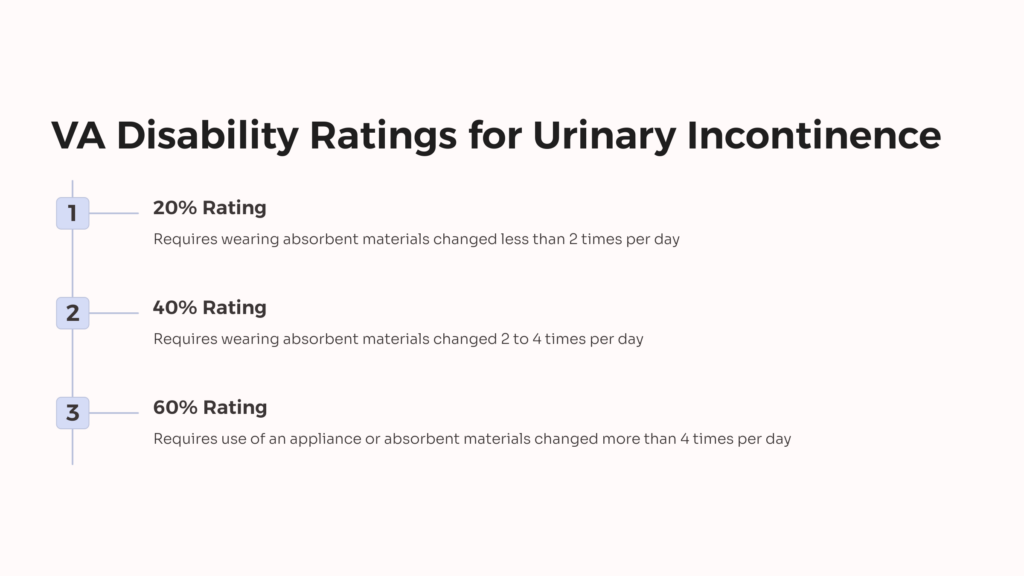
The VA rates urinary incontinence under the category of voiding dysfunction. The rating criteria are based on the severity of symptoms and their impact on daily life. Here’s a breakdown of the possible ratings:
- 20% rating: Requires wearing of absorbent materials which must be changed less than 2 times per day.
- 40% rating: Requires wearing of absorbent materials which must be changed 2 to 4 times per day.
- 60% rating: Requires use of an appliance or the wearing of absorbent materials which must be changed more than 4 times per day.
It’s important to note that these ratings are based on the need for absorbent materials and the frequency of changes. If you’re managing your incontinence through other means, such as frequent bathroom trips, you might be rated under urinary frequency instead:
- 10% rating: Daytime voiding interval between two and three hours, or; awakening to void two times per night.
- 20% rating: Daytime voiding interval between one and two hours, or; awakening to void three to four times per night.
- 40% rating: Daytime voiding interval less than one hour, or; awakening to void five or more times per night.
According to VA Claims Insider, the VA uses diagnostic code 7517 for rating bladder injuries under the voiding dysfunction system. This information can be helpful when discussing your condition with your healthcare provider or VA representative.
Secondary Service-Connected Disability
In many cases, urinary incontinence may be considered a secondary service-connected disability. This means that while the incontinence itself may not have been directly caused by military service, it’s the result of another condition that is service-connected.
For example, a veteran with service-connected PTSD might develop urinary incontinence as a result of their mental health condition. In this case, the incontinence could be claimed as a secondary disability to PTSD. Similarly, a veteran with a service-connected back injury might develop incontinence due to nerve damage, making the incontinence secondary to the back condition.
To establish a secondary service connection, you need to provide medical evidence linking your urinary incontinence to your primary service-connected condition. This often requires a medical opinion or nexus letter from a healthcare provider.
It’s important to note that secondary service-connected disabilities are rated and compensated in the same way as primary conditions. This means that even if your incontinence is secondary to another condition, you can still receive the full rating and compensation for its severity.
Proving Eligibility for a VA Disability Rating
To receive a VA disability rating for urinary incontinence, you need to prove three key elements:
1. A current diagnosis of urinary incontinence
2. An in-service event, injury, or illness that could have caused or contributed to the incontinence
3. A medical nexus (link) between your current condition and the in-service event
For a current diagnosis, you’ll need medical records documenting your urinary incontinence. This could include treatment notes, test results, or a letter from your healthcare provider detailing your condition.
The in-service event could be a direct injury, exposure to toxins, or the onset of a condition that later led to incontinence. Your service records, including medical records and incident reports, can be valuable in establishing this element.
The medical nexus is often the most challenging part to prove. A nexus letter from a qualified medical professional can be crucial here. This letter should explain how your military service likely caused or contributed to your current urinary incontinence.
If you’re claiming incontinence as a secondary condition, you’ll need to prove the link between your primary service-connected disability and your incontinence. Again, a medical opinion is usually necessary to establish this connection.
Remember, the VA has a duty to assist you in obtaining relevant records. Don’t hesitate to ask for help in gathering the necessary evidence for your claim.
Conditions Similar to Urinary Incontinence
When filing a VA claim for urinary incontinence, it’s important to be aware of related conditions that may have similar symptoms or be rated under similar criteria. Understanding these can help ensure you’re claiming all appropriate conditions and receiving the full compensation you’re entitled to.
Urinary frequency is a condition often associated with incontinence. While it doesn’t necessarily involve involuntary leakage, it can significantly impact daily life. The VA rates urinary frequency separately from incontinence, with ratings based on how often you need to urinate during the day and night.
Urinary tract infections (UTIs) are another related condition. Chronic or recurrent UTIs can lead to incontinence and may be rated separately if they require long-term drug therapy or hospitalization.
Prostate conditions in men, such as benign prostatic hyperplasia (BPH) or prostate cancer, can cause urinary symptoms similar to incontinence. These conditions have their own rating criteria but may also be considered in relation to incontinence claims.
For women veterans, pelvic floor disorders or gynecological conditions may contribute to urinary incontinence. These conditions may be rated separately but could support a claim for incontinence as a secondary condition.
It’s crucial to discuss all your symptoms with your healthcare provider and VA representative to ensure all related conditions are properly evaluated and rated.
How to File a VA Claim for Urinary Incontinence
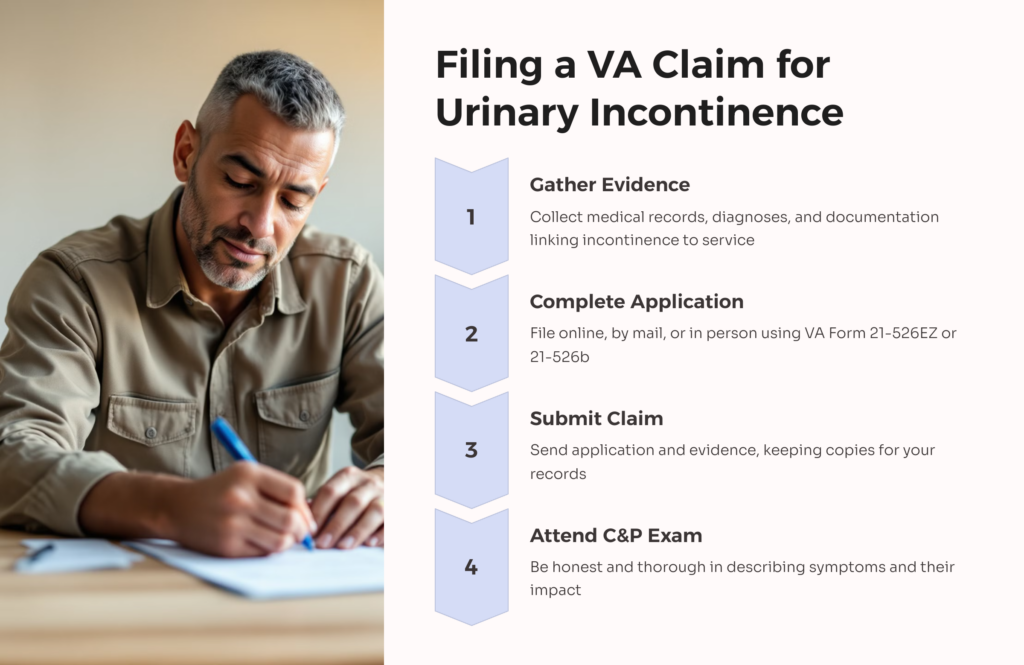
Filing a VA claim for urinary incontinence follows the same general process as other VA disability claims. Here’s a step-by-step guide:
1. Gather your evidence: Collect all relevant medical records, including diagnoses, treatment plans, and any documentation linking your incontinence to your military service or a service-connected condition.
2. Complete the application: You can file your claim online through the VA.gov website, by mail, or in person at a VA regional office. The primary form you’ll need is VA Form 21-526EZ for new claims or VA Form 21-526b for secondary or increased rating claims.
3. Submit your claim: Once you’ve completed the application and gathered your evidence, submit everything together. Make sure to keep copies of all documents for your records.
4. Attend a C&P exam: The VA may schedule you for a Compensation and Pension (C&P) exam. This is an opportunity for a VA-contracted medical professional to assess your condition. Be honest and thorough in describing your symptoms and how they impact your daily life.
5. Wait for a decision: The VA will review your claim and send you a decision letter. This process can take several months, so be patient.
6. Appeal if necessary: If you disagree with the VA’s decision, you have the right to appeal. Consider seeking help from a Veterans Service Organization or a VA-accredited attorney for the appeals process.
Remember, the key to a successful claim is providing clear, comprehensive evidence of your condition and its connection to your military service.
Tips for a Successful VA Disability Claim
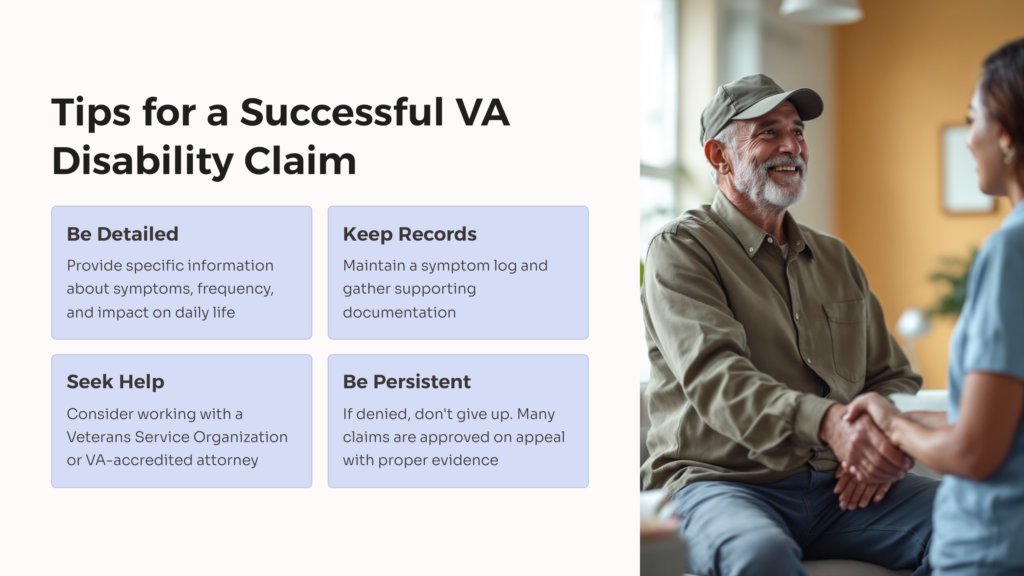
When filing a VA disability claim for urinary incontinence, consider these tips to increase your chances of a favorable outcome:
1. Be detailed and specific: When describing your symptoms, be as detailed as possible. Include information about frequency, severity, and how the condition impacts your daily life and work.
2. Keep a symptom log: Document your incontinence episodes, including frequency, severity, and any triggers. This can provide valuable evidence for your claim.
3. Get a strong nexus letter: A well-written nexus letter from a qualified medical professional can significantly strengthen your claim. Make sure the letter clearly explains how your military service or service-connected condition led to your incontinence.
4. Don’t downplay your symptoms: It’s common for veterans to minimize their health issues, but when filing a claim, it’s important to be honest about the full extent of your condition.
5. Consider secondary connections: If your incontinence is related to another service-connected condition, make sure to claim it as a secondary disability.
6. Include buddy statements: Statements from fellow service members, family, or friends who can attest to your condition and its impact on your life can provide valuable supporting evidence.
7. Meet all deadlines: The VA claim process involves several deadlines. Make sure you respond to all VA requests for information promptly to avoid delays or denials.
8. Seek professional help: Consider working with a Veterans Service Organization or a VA-accredited attorney. They can provide valuable guidance throughout the claims process.
Remember, persistence is key. If your initial claim is denied, don’t give up. Many claims are approved on appeal with the right evidence and presentation.
Frequently Asked Questions about VA Ratings for Incontinence
Here are some common questions veterans have about VA disability ratings for urinary incontinence:
1. Can I get VA disability for incontinence if it started after I left the military?
Yes, if you can prove it’s related to a service-connected condition or was caused by an event during your military service.
2. How does the VA determine the severity of urinary incontinence?
The VA primarily looks at the need for absorbent materials and how often they need to be changed, or the frequency of urination.
3. Can I receive separate ratings for urinary incontinence and urinary frequency?
Generally, no. The VA will assign one rating based on whichever criteria results in the higher evaluation.
4. What if my incontinence is due to a mental health condition like PTSD?
You may be able to claim incontinence as a secondary condition to your service-connected mental health disorder.
5. How often can I request an increase in my rating for urinary incontinence?
You can file for an increased rating whenever your condition worsens. There’s no specific time limit between claims.
6. Will the VA provide supplies for managing incontinence?
Yes, if you have a service-connected rating for incontinence, the VA should provide necessary supplies.
7. Can urinary incontinence qualify me for Total Disability based on Individual Unemployability (TDIU)?
While it’s less common, severe incontinence that significantly impacts your ability to work could potentially contribute to a TDIU claim.
Remember, every veteran’s situation is unique. If you have specific questions about your claim, it’s best to consult with a VA representative or a veterans’ advocate for personalized advice. Get started today by taking our free medical evidence screening at AllVeteran.com.
 AllVeteran.com Advisors
AllVeteran.com Advisors
With expertise spanning local, state, and federal benefit programs, our team is dedicated to guiding individuals towards the perfect program tailored to their unique circumstances.








